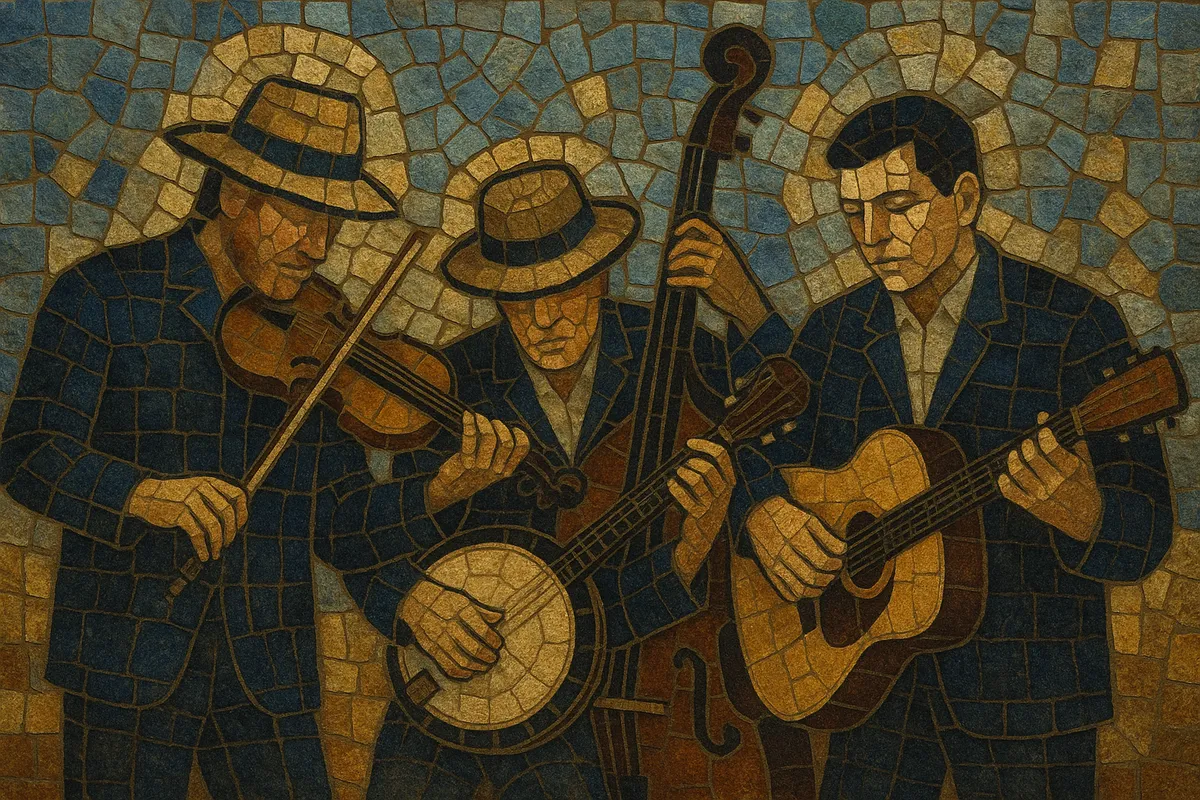
Traditional bluegrass is an acoustic string-band music that crystallized in the mid‑1940s around Bill Monroe and His Blue Grass Boys. It is defined by the "high lonesome" vocal sound, breakneck ensemble drive, and virtuosic instrumental breaks traded among banjo, fiddle, mandolin, guitar, and upright bass, with no drums or electric instruments.
Core features include three-finger Scruggs‑style banjo, mandolin back‑beat "chop" on the off‑beats, flatpicked guitar runs (e.g., the G‑run), and strong two‑beat bass. Repertoires span breakdowns, fiddle tunes, gospel quartets, murder ballads, and sentimental songs, typically arranged with a kickoff, alternating verses/choruses, instrumental solos ("breaks"), and a tag ending.
Harmonically it favors I–IV–V progressions with Mixolydian flavors (♭VII), relative minors, and occasional secondary dominants. Performances often gather around a single microphone, balancing parts dynamically while maintaining the music’s raw, propulsive energy.
Traditional bluegrass coalesced in the mid‑1940s in the United States when mandolinist Bill Monroe’s Blue Grass Boys added guitarist Lester Flatt and banjo innovator Earl Scruggs. Scruggs’s three‑finger roll transformed the rhythmic engine of old‑time string bands into something faster, brighter, and more syncopated. The style drew on Appalachian old‑time fiddle tunes and ballads, African American blues and banjo traditions, white gospel quartet singing, and the showmanship and repertoire breadth of country radio barn dances.
Monroe, Flatt & Scruggs, and The Stanley Brothers set the template: acoustic instrumentation (fiddle, mandolin, 5‑string banjo, guitar, bass), no drums, tight trio/quartet harmonies, and a balance of breakdowns, gospel numbers, and lonesome ballads. Signature recordings such as “Blue Moon of Kentucky,” “Foggy Mountain Breakdown,” and “Molly and Tenbrooks” codified the form and techniques that define the traditional sound.
The 1960s folk revival and the birth of dedicated bluegrass festivals helped preserve and spread the style to new audiences. While progressive offshoots (often called "newgrass") experimented with harmony, repertoire, and rhythm, a core of traditionalists maintained the hard‑driving, pre‑electric approach. Institutional support grew with organizations like the International Bluegrass Music Association (IBMA, founded 1985), which promoted education, awards, and archival work.
Younger bands kept to classic techniques—single‑mic staging, Scruggs banjo, mandolin chop—while benefiting from renewed mainstream interest sparked by projects like the O Brother, Where Art Thou? soundtrack (2000). Today, traditional bluegrass remains a living practice at jams, contests, and festivals, sustaining its repertoire and performance customs while inspiring adjacent roots genres.
Use an all‑acoustic lineup: 5‑string banjo (three‑finger Scruggs style), mandolin, fiddle, flat‑top steel‑string guitar, and upright bass; resonator guitar (dobro) is common but optional. Do not use drums or electric amplification for tone shaping—aim for natural projection and a tight ensemble blend.
Establish a two‑beat feel with the bass hitting beats 1 and 3. The guitar provides boom‑chuck (alternating bass note and strum), the mandolin “chops” on the off‑beats (2 and 4), and the banjo drives with flowing rolls (forward, backward, forward‑reverse), punctuated by slides, hammers, and pinches. Fiddle uses Nashville and Georgia shuffles to reinforce pulse. Fast breakdowns typically sit ~120–160+ BPM; waltzes are in 3/4.
Favor I–IV–V progressions, Mixolydian color (♭VII), and occasional ii–V or V/V turnarounds. Common keys are G, A, B, D; use capos to keep open‑string resonance. Melodies are diatonic with bluesy inflections; craft clear, singable hooks that leave room for instrumental responses.
Begin with a short instrumental kickoff stating the tune. Alternate verses and choruses with single‑instrument “breaks” for banjo, fiddle, mandolin, and guitar. End with a tag lick. Keep solo lengths concise to maintain momentum and feature multiple instruments.
Aim for the “high lonesome” timbre: a high lead with tenor and baritone harmonies (duo/trio; quartet for gospel). Themes include heartbreak, rural life, trains, work, faith, and traditional ballad narratives (including murder ballads). Keep verses economical and imagery concrete.

